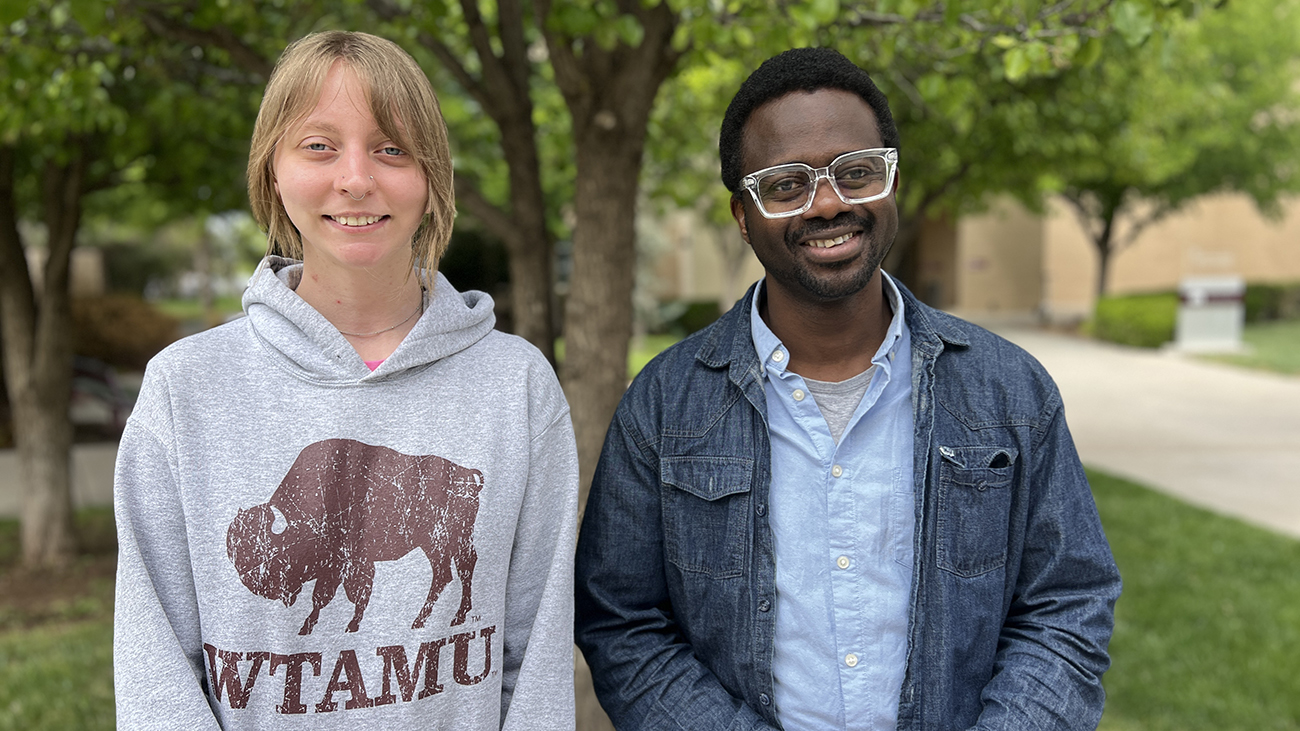- Featured
- Research
- Science
WT Students Take Part in Study Abroad Trip to Research Arctic Cloud Formation
Copy by Chip Chandler, 806-651-2124, cchandler@wtamu.edu
CANYON, Texas — Two West Texas A&M University students recently traveled north—far north—to study how climate changes are impacting the Arctic.
Ava Sealy, a senior environmental science major from Lovington, New Mexico, and Olwaseyi Adelaja “Victor” Sanusi, a graduate student in environmental science from both Norway and Nigeria, both worked in the Gruvebadet Atmospheric Laboratory and Dirigible Italia Arctic Station in Ny-Ålesund in Svalbard, Norway, in the spring.
The duo was studying aerosols, or ice-nucleating particles, which are the microscopic material in the air that water vapor condenses around to form ice crystals that make up clouds.
Previous WT researchers—both students and faculty—have conducted similar studies in Alaska, the Azores, Northeast Oklahoma and the Canyon area as part of international research campaigns that are examining ice-nucleating particles.
“This research provides a meaningful science education experience for our students,” said Dr. Naruki Hiranuma, associate professor of environmental sciences in WT’s Paul Engler College of Agriculture and Natural Sciences. “Our data from the European Arctic complements previous projects conducted in North America and elsewhere, ultimately benefitting researchers everywhere.”
Traveling so far north was a crucial step, Sealy said.
“In the Arctic, climate change is happening a lot faster and there’s not a lot of research on it, so that’s why we’re focusing on it,” she said.
While at the research station, the duo—who were supervised on site by the National Research Council of Italy’s Tessa Viglezio and Veronica Coppolaro at the Institute of Polar Sciences—looked at different biological and chemical catalysts to determine at what rate they would freeze.
“Say, for instance, you have two buckets of water,” Sanusi explained. “You contaminate one, then see which one freezes faster. Ultimately, you want to figure out why one freezes faster than the other.”
“Nobody really knows how some particles are ice-nucleating and some are not,” Sealy added. “It’s really new research. Only a few are doing it.”
The students traveled to Norway through WT’s Study Abroad office and with the assistance of a National Science Foundation grant.
The experience was remarkable, both students said.
“Study Abroad has given me the opportunity to expand the different types of research I’ve done, to be both in the field collecting samples and to be in the lab analyzing them,” Sealy said.
“It’s given me the opportunity to meet other researchers,” Sanusi said. “I’ve now been in this field for some time, but this is giving me the chance to learn something new that I’ll be able to take to the job market.”
This was a particularly impactful Study Abroad trip, said Amber Black, assistant vice president for student success and well-being.
“They both got hands-on experience that helps them both in their current coursework and in their future careers in environmental science,” Black said. “That’s exactly why we offer Study Abroad opportunities for WT students.”
A focus on regionally impactful research is a key component of the University’s long-range plan, WT 125: From the Panhandle to the World.
That plan is fueled by the historic One West comprehensive fundraising campaign, which reached its initial $125 million goal 18 months after publicly launching in September 2021. The campaign’s new goal is to reach $175 million by 2025; currently, it has raised more than $150 million.
About West Texas A&M University
WT is located in Canyon, Texas, on a 342-acre residential campus. Established in 1910, the University has been part of The Texas A&M University System since 1990. WT, a Hispanic Serving Institution since 2016, boasts an enrollment of about 10,000 and offers 59 undergraduate degree programs and more than 40 graduate degrees, including two doctoral degrees. The University is also home to the Panhandle-Plains Historical Museum, the largest history museum in the state and the home of one of the Southwest’s finest art collections. The Buffaloes are a member of the NCAA Division II Lone Star Conference and offers 14 men’s and women’s athletics programs.
Photo: Ava Sealy, a senior environmental science major from Lovington, New Mexico, and Olwaseyi Adelaja “Victor” Sanusi, a graduate student in environmental science from both Norway and Nigeria, both worked in the Gruvebadet Atmospheric Laboratory and Dirigible Italia Arctic Station in Ny-Ålesund in Svalbard, Norway, in the spring.
—WT—

